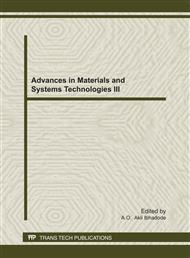[1]
Demirbas, A., "Political, economic and environmental impacts of biofuels: A review. Applied Energy 86, 2009, S108-S117.
DOI: 10.1016/j.apenergy.2009.04.036
Google Scholar
[2]
Redman, G., The Andersons Centre. Assessment of on-farm AD in the UK, National Non-Food Crops Centre, 2008-06-09.
Google Scholar
[3]
Evans, G. Liquid Transport Biofuels – Technology Status Report", National Non-Food Crops Centre, 2008-04-14. , Council Directive 85/536/EEC of December 1985 on crude-oil savings through the use of substitute fuel components in petrol.
Google Scholar
[4]
Yeoman C.J., Han Y., Dodd D. Schroeder C.M., Mackie R.I. & Cant I.K., Thermostable enzymes as biocatalysts in the biofuel industry, Advances in Applied Microbiology 70, 2010, 1 – 55.
DOI: 10.1016/s0065-2164(10)70001-0
Google Scholar
[5]
Torien D.F. & Kotze J.P., Population Description of Non-methanogeric phase of Anaerobic Digestion, Water Resources. 4, 1997, 129 (i); 285.
Google Scholar
[6]
Porter J.R., Microbiology and Disposal of Solid Wastes,. Amer. Soc. Microbiology News. 40, 1974, 826.
Google Scholar
[7]
Porter J.R., Micro-organisms as Natural Resources for Food and Energy,. Presented to the Asian Regional Seminar on Contributions of Science and Technology to National Development, New Delhi, 4 – 6 October, (1978).
Google Scholar
[8]
Chris Somerville, Development of Cellulosic Biofuels". Speech presented at Government, s OCE Forum, U.S. Dept. of Agriculture, April (2007).
Google Scholar
[9]
Oliver R. Inderwildi & David A. King, Quo Vadis Biofuels,. Energy & Environmental Science 2, 2009, 343.
DOI: 10.1039/b822951c
Google Scholar
[10]
Cedric Briens, Jan Piskorz and Franco Berruti., Biomass Valorization for Fuel and Chemicals Production – A Review, International Journal of Chemical Reactor Engineering, 6, 2008, R2.
DOI: 10.2202/1542-6580.1674
Google Scholar
[11]
Olembo R. Dasilva E.J., & Burgers A., Integrated Microbial Technology for Developing Countries: Springboard for Economic Progress,. Impact Sci. Soc. 28, 1978, 159.
Google Scholar
[12]
Harold B. Gotaas, "Manure and Night-Soil Digesters for Methane Recovery on Farms and in villages. Composting: Sanitary Disposal and Reclamation of Organic Wastes. Chap. 9, 1956, 171-199. University of California, World Health Organization.
Google Scholar


